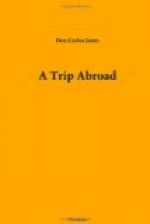After a visit to what is called the Pool of Bethesda and the Church of St. Anne, we went outside the city wall on the north side and entered what looks like a cave, but upon investigation proves to be an extensive underground quarry. These excavations, called Solomon’s Quarries, extend, according to one authority, seven hundred feet under the hill Bezetha, which is north of Mt. Moriah. The rock is very white, and will take some polish. Loose portions of it are lying around on the floor of the cavern, and there are distinct marks along the sides where the ancient stone-cutters were at work. In one part of the quarries we were shown the place where visiting Masons are said to hold lodge meetings sometimes. Vast quantities of the rock have been taken out, and this is probably the source from whence much of the building material of the old city was derived.
The trip to the quarries ended my sight-seeing for the week. The next morning I went to the Church of the Holy Sepulcher and witnessed a part of the service of the Greek Catholics. At a later hour I went around to the mission conducted by Bro. Joseph, and, with the little congregation there assembled, broke bread in memory of Him who in this city, almost two thousand years ago, gave his life for the sins of the world, after having instituted this supper, a monumental institution, representing to our minds the cost of the world’s redemption. In the afternoon I attended the preaching service in Mr. Thompson’s tabernacle, and visited the Abyssinian church, near Mr. Smith’s house. This Abyssinian house is circular, and has a small, round room in the center, around which the congregation stands and worships, leaning on their staves, for the place is void of seats. At night I preached in the tabernacle on the question: “What must I do to be saved?” Melki, the native evangelist, translated for me as I went along, and the congregation paid good attention and seemed pleased to have heard me. I know I am pleased to have had opportunity to “preach the word” in the city from whence it was first published to the world.
One of the first sights beheld when I started out on Monday morning was a foundation, laid at the expense of a woman who intended to build a house for the “hundred and forty-four thousand.” It represents one of the many peculiar religious ideas that find expression in and around Jerusalem. We went on to the railway station, where I saw a young man, a Jew, leave for that far-off land called America. Next the Leper Hospital was visited. This well-kept institution is in the German colony, and had several patients of both sexes. A lady, who spoke some English, kindly showed me through the hospital, and explained that the disease is not contagious, but hereditary, and that some lepers refuse to enter the hospital because they are forbidden to marry. The patients were of various ages, and showed the effects of the disease in different stages. In some cases it makes the victim a sad sight to look upon. I remember one of these poor, afflicted creatures, whose face was almost covered with swollen and inflamed spots. Some were blind, and some had lost part or all of their fingers by the disease. One man’s nose was partly consumed.




